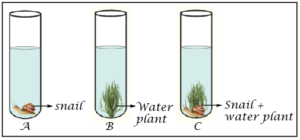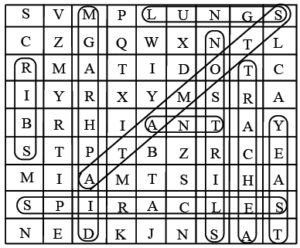NCERT Solutions Class 7 Science Chapter 10 Respiration in Organisms is crucial for the students of 7th standard. The solutions are provided here to help students understand the Chapter in an interesting way. These NCERT Solutions for Class 7 Science Chapter 10 are created by subject experts according to the latest CBSE syllabus. Students must practise the solutions regularly to prepare effectively for their examination.
NCERT Solutions for Class 7 Science Chapter 10 are outlined in such a way that every student can comprehend the concepts easily. These solutions comprise a wide range of topics.
CHAPTER 10_RESPIRATION IN ORGANISMS NCERT SOLUTIONS
1.Why does an athlete breathe faster and deeper than usual after finishing therace ?
A. i) An athlete needs extra energy to his muscle cells during running.
ii) For this, he breathes faster and deeper so that more oxygen is supplied to the
iii) This speeds up the breakdown of food and as a result, more energy is released.
2. List the similarities and differences between aerobic and anaerobic respiration.
A. Similarity between aerobic and anaerobicrespiration :
In both aerobic and anaerobic respiration, the food is broken down to release energy.
Differences between aerobic and anaerobic respiration :
| AEROBIC RESPIRATION | ANAEROBIC RESPIRATION |
| i) In this process, food materials are broken down in the presence of oxygen. | i) In this process, food materials are broken down in the absence of oxygen. |
| ii) Its end products are CO2 and H2O.
|
ii) End products of anaerobic respiration can be lactic acid or alcohol and CO2. |
| iii) It takes longer time to release energy. | iii) It is a fast process as compared to aerobic respiration. |
| iv) It produces large amount of energy.
|
iv) It produces small amount of energy.
|
| v) Glucose + water + energy. | v) Glucose + energy. |
3. Why do we often sneeze when we inhale a lot of dust-laden air?
A. i) When we inhale some unwanted or foreign particles (smoke, dust, pollen etc.) get trapped in our nasal cavity and cause irritation.
ii) This irritation causes sneezing.
iii) Sneezing expels the foreign particles from the inhaled air, so that only clean air enters our body.
4. Take three test-tubes. Fill 3/4thof each with water. Label them A, B and C. Keep a snail in test-tube A, a water plant in test-tube B and in C keep both snail and plant. Which test-tube would have the highest concentration ofCO2 ? Why ?
A.

i) Test tube A will have the highest concentration of CO2. This is because test tube A contains snail. Snail breathes in O2and breathes out CO2. Hence, CO2concentration increases in test tube A.
ii) Test tube B contains a water plant, which takes in CO2for the synthesis of food and gives out O2. Hence, more O2concentration is found in test tube B.
iii) Test tube C contains both a snail and a plant. The CO2 produced by the snail is utilized by the plant for the synthesis of its food and the O2 released by the plant is utilized by the snail for respiration.
Therefore, test tube A has the highest concentration of CO2.
5. Tick (√) the correctanswer :
a. In cockroaches, air enters the body through
i) lungs ii) gills iii) spiracles (√) iv) skin
b. During heavy exercise, we get cramps in the legs due to the accumulation of
i) carbon dioxide ii) lactic acid (√) iii) alcohol iv) water
C. Normal range of breathing rate per minute in an average adult person at rest is
i) 9-12 ii) 15-18 (√) iii) 21-24 iv) 30-33
d. During exhalation, the ribs
i) move outwards ii) move downwards (√)
iii) move upwards iv) do not move at all
6. Match the items in Column I with those in Column II
Column I Column II
1) Yeast ( ) A) Earthworm
2) Diaphragm ( ) B) Gills
3) Skin ( ) C) Alcohol
4) Leaves ( ) D) Chest cavity
5) Fish ( ) E) Stomata
6) Frog ( ) F) Lungs and skin
G) Tracheae
A. 1) C 2) D 3) A 4) E 5) B 6) F
7. Mark ‘T’ if the statement is true and ‘F’ if it is false:
i) During heavy exercise the breathing rate of a person slows down. ( F )
ii) Plants carry out photosynthesis only during the day and respiration only at ( F )
iii) Frogs breathe through their skins as well as their lungs. ( T )
iv) The fishes have lungs for respiration. ( F )
v) The size of the chest cavity increases during inhalation. ( T )
8. Given below is a square of letters in which are hidden different words related to respiration in organisms. These words may be present in any direction“ upwards, downwards, or along the diagonals”. Find the words for your respiratory system. Clues about those words are given below the square.
| S | V | M | P | L | U | N | G | S |
| C | Z | G | Q | W | X | N | T | L |
| R | M | A | T | I | D | O | T | C |
| I | Y | R | X | Y | M | S | R | A |
| B | R | H | I | A | N | T | A | Y |
| S | T | P | T | B | Z | R | C | E |
| M | I | A | M | T | S | I | H | A |
| S | P | I | R | A | C | L | E | S |
| N | E | D | K | J | N | S | A | T |
i) The air tubes of insects
ii) Skeletal structures surrounding chest cavity
iii) Muscular floor of chest cavity
iv) Tiny pores on the surface of leaf
v) Small openings on the sides of the body of an insect
vi) The respiratory organs of human beings
vii) The openings through which we inhale
viii) An anaerobic organism
ix) An organism with tracheal system.
A.

i) Trachea ii) Ribs iii) Diaphragm iv) Stomata
v) Spiracles vi) Lungs vii) Nostrils viii) Yeast
ix) Ant
9. The mountaineers carry oxygen with them because:
a) At an altitude of more than 5 km there is no air.
b) The amount of air available to a person is less than that available on the
c) The temperature of air is higher than that on the ground.
d) The pressure of air is higher than that on the ground.
A. “The amount of air available to a person is less than that available on the ground.”
10.Define the term “breathing rate”.
A. The number of times a person breathes in a minute is termed the “breathing rate”.
Important topics covered in NCERT Solutions for Class 7 Science Chapter 10 Respiration in Organisms
- Why do we respire?
- Breathing
- How do we breathe?
- What do we breathe out?
- Breathing in other animals
- Breathing underwater
- Do plants also respire?
INFINITY LEARN presents you with NCERT Solutions that will help you to grasp the topics. These NCERT Solutions are the result of thorough research and the experience of INFINITY LEARN subject experts.
Frequently Asked Questions on NCERT Solutions for Class 7 Science Chapter 10
What are the similarities between aerobic and anaerobic respiration in the Chapter 10 of NCERT Solutions for Class 7 Science?
The similarities between aerobic and anaerobic respiration in the Chapter 10 of NCERT Solutions for Class 7 Science are –
1. Food particles are broken down to release energy.
Students under the CBSE board can download the NCERT Solutions from INFINITY LEARN to get a clear idea about this concept. The solutions can also be used by the students to answer the exercise questions with ease. The faculty have designed the solutions after conducting vast research on each concept to help students score well in the annual exam.
Why do humans sneeze when they inhale dust laden air in the Chapter 10 of NCERT Solutions for Class 7 Science?
When humans inhale dust laden air, the dust causes irritation in the nose which in turn is thrown out by sneezing. To know more about the respiration in both animals and plants, students need to refer to the solutions present at INFINITY LEARN. The experts have framed the solutions as per the latest CBSE syllabus and guidelines to help students perform well in the annual exam. Each and every minute detail present in the NCERT textbook is explained in a systematic way to improve problem solving abilities among students.
What are the important topics in the Chapter 10 of NCERT Solutions for Class 7 Science?
The important topics in the Chapter 10 of NCERT Solutions for Class 7 Science are –
1. Why do we respire?
2. Breathing
3. How do we breathe?
4. What do we breathe out?
5. Breathing in other animals
6. Breathing underwater
7. Do plants also respire?



